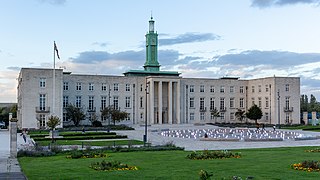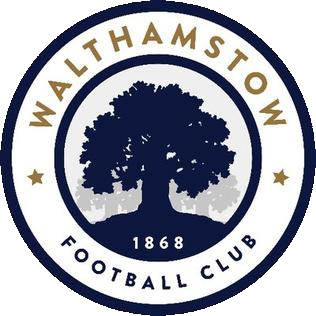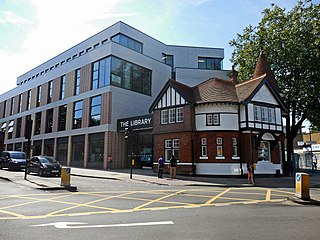
Chingford is a town in east London, England, within the London Borough of Waltham Forest. The centre of Chingford is 9.2 miles (14.8 km) north-east of Charing Cross, with Waltham Abbey to the north, Woodford Green and Buckhurst Hill to the east, Walthamstow to the south, and Edmonton and Enfield to the west.

Leyton is a town in east London, England, within the London Borough of Waltham Forest. It borders Walthamstow to the north, Leytonstone to the east, and Stratford to the south, with Clapton, Hackney Wick and Homerton, across the River Lea, to the west. The area includes New Spitalfields Market, Leyton Orient Football Club, as well as part of the Queen Elizabeth Olympic Park. The town consists largely of terraced houses built between 1870 and 1910, interspersed with some modern housing estates. It is 6.2 miles (10 km) north-east of Charing Cross.

Walthamstow is a town in the London Borough of Waltham Forest, around 7.5 miles (12 km) northeast of Central London. The town borders Chingford to the north, Snaresbrook and South Woodford to the east, Leyton and Leytonstone to the south, and Tottenham to the west. At the 2011 census, the town had a population of approximately 109,424.

The London Borough of Waltham Forest is an outer London borough formed in 1965 from the merger of the municipal boroughs of Leyton, Walthamstow and Chingford.

Leytonstone is an area in East London, England, within the London Borough of Waltham Forest. It adjoins Wanstead to the north-east, Forest Gate to the south-east, Stratford to the south-west, Leyton to the west, and Walthamstow to the north-west, and is 7 miles (11 km) north-east of Charing Cross.

Tottenham Hale is a district of north London and part of the London Borough of Haringey, bounded by the River Lea and located to the south/south-east of Tottenham proper. From 1850 to 1965, it was part of the Municipal Borough of Tottenham, in Middlesex.

The Walthamstow Pumphouse Museum is a museum based in Walthamstow, in the London Borough of Waltham Forest. It is based in and around Low Hall Pumping Station, a Grade II listed building, originally built as a sewage pumping station in 1885.

Sir Frank William Brangwyn was a Welsh artist, painter, watercolourist, printmaker, illustrator, and designer.
Madge Gill, was an English outsider and visionary artist.

Walthamstow is a constituency in Greater London created in 1974 and represented in the House of Commons of the UK Parliament since 2010 by Stella Creasy, a member of the Labour and Co-operative Party, in political union with the Labour Party.
Highams Park is a district in the London Borough of Waltham Forest, England, near Epping Forest and 8.1 miles (13 km) north-east of Charing Cross.

Walthamstow Football Club are a semi-professional football club based in Walthamstow, who play in the Isthmian League North Division. They have played under a number of names and were known as Leyton Pennant up until the end of the 2002–03 season, and Waltham Forest until the end of the 2017–18 season.

The Soho Theatre is a theatre and registered charity in the Soho district of the City of Westminster, in London, England. It produces and presents new works of theatre, together with comedy and cabaret, across three performance spaces.

Walthamstow Bus Station serves Walthamstow town centre in Waltham Forest, London, England. The station is owned and maintained by Transport for London. The station can be accessed from both Selborne Road and High Street as well as Walthamstow Central tube station. Fifteen bus routes serve the station, with three night bus routes also serving the station.

The Library at Willesden Green is a public library complex situated in Willesden Green, London, United Kingdom. The centre includes a public library which spans over 3 floors, and includes a library for children. It includes 40,000 books, and offers computer and study spaces. The library is operated by Brent Council and houses governmental archives on Brent. Since 2006, the Brent Museum has been located in the building and since the 2015 redevelopment, a performing arts space, as well as an art exhibition gallery, was added to the building.

Waltham Forest Town Hall is a municipal building located in Walthamstow, East London. The town hall, which is the headquarters of Waltham Forest London Borough Council, is a Grade II Listed Building.

F. G. Southgate, ARIBA, was the borough architect, engineer and surveyor, for the Municipal Borough of Walthamstow, in Essex, England, in the post-Second World War period.
RIBA National Awards are part of an awards program operated by the Royal Institute of British Architects, also encompassing the Stirling Prize, the European Award and the International Award. The National Awards are given to buildings in the UK which are "recognised as significant contributions to architecture" which are chosen from the buildings to receive an RIBA Regional award.





















